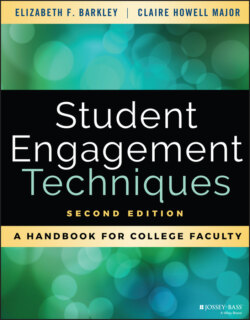Читать книгу Student Engagement Techniques - Elizabeth F. Barkley - Страница 67
Integrating the Cognitive, Affective, and Psychomotor Domains
ОглавлениеIn some fields, experts must be skilled in all three domains. An accomplished classical pianist must be able to read abstract musical notation, memorize thousands of notes, create a unique interpretation by synthesizing what he knows and understands about the piece's historical context with what he believes to be the composer's concept, blend this with his personal artistic vision, and perform physically in a nuanced manner at split-second speed. Similar domain spanning is evident in the work of actors, surgeons, archeologists, athletes, and others. From one perspective, student engagement may be the process and product of spanning domain boundaries and taking advantage, in an intentional way, of the contributions of each.
Many of the current thinkers on education recognize this complexity. Fink (2003) proposed his taxonomy of significant learning because he believed that higher education was expressing a need for new kinds of learning: leadership and interpersonal skills, ethics, communication skills, character, tolerance, and the ability to adapt to change (p. 29). These kinds of learning go beyond the cognitive domain. Shulman's (2002) table of learning involves cognitive, affective, and psychomotor elements and is integrative and cyclical rather than hierarchical. The expanded concepts of Fink (2003) and Shulman (2002) are supported by other new approaches. In “College Learning for the New Global Century: A Report from the National Leadership Council for Liberal Education & America's Promise” (Association of American Colleges and Universities, 2007), for example, the authors urge educators to abandon narrow learning and suggest that essential learning outcomes include knowledge of human cultures and the physical and natural world, personal and social responsibility, and integrative learning.
Arguably, the most effective—and engaging—learning environments integrate domains. The learning activities that teachers design to help students progress cognitively will be most successful if students are engaged on an affective level (they enjoy the tasks and give the tasks their full attention) and, when possible and appropriate, a kinesthetic level (students apply the theoretical and abstract by actually “doing” a physical activity). In our double helix model of engagement, teaching for “holistic” learning can contribute to synergy because it supports active learning (learners are thinking and caring about what they are doing and doing what they are thinking and caring about) and it also enhances motivation (many students find domain-spanning activities intrinsically more interesting and enjoyable, other students find domain-spanning activities necessary to be more successful learners).
